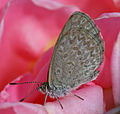
Indigo dye is an organic compound with a distinctive blue color. Indigo is a natural dye extracted from the leaves of some plants of the Indigofera genus, in particular Indigofera tinctoria; dye-bearing Indigofera plants were commonly grown and used throughout the world, in Asia in particular, as an important crop, with the production of indigo dyestuff economically important due to the historical rarity of other blue dyestuffs
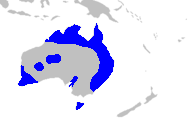
Xanthorrhoea is a genus of about 30 species of flowering plants endemic to Australia. Species are known by the name grass tree.

Primula vulgaris, the common primrose, is a species of flowering plant in the family Primulaceae, native to western and southern Europe, northwest Africa, and parts of southwest Asia. The common name is primrose, or occasionally common primrose or English primrose to distinguish it from other Primula species also called primroses. None of these are closely related to the evening primroses.

Indigofera tinctoria, also called true indigo, is a species of plant from the bean family that was one of the original sources of indigo dye.

Baptisia australis, commonly known as blue wild indigo or blue false indigo, is a flowering plant in the family Fabaceae (legumes). It is a perennial herb native to much of central and eastern North America and is particularly common in the Midwest, but it has also been introduced well beyond its natural range. Naturally it can be found growing wild at the borders of woods, along streams or in open meadows. It often has difficulty seeding itself in its native areas due to parasitic weevils that enter the seed pods, making the number of viable seeds very low. The plant has low toxicity levels for humans.
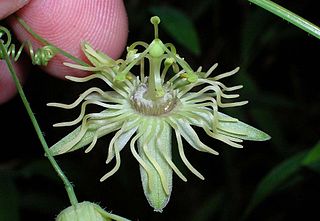
Passiflora lutea, commonly known as yellow passionflower, is a flowering perennial vine in the family Passifloraceae, native to the central and eastern United States. The vine has three-lobed leaves and small, yellowish-green, fringed flowers that appear in the summer, followed by green fruit that turn almost black at maturity. It grows in moist to wet habitats.

Xanthorrhoea australis, the grass tree, austral grasstree or blackboy, is an Australian plant. It is the most commonly seen species of the genus Xanthorrhoea. Its trunk can grow up to several metres tall and is often branched. In certain Aboriginal languages, it is called bukkup, baggup or kawee.
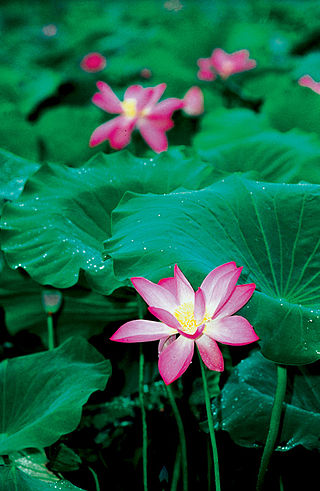
This is a list of plants commonly found in Kakadu National Park, Northern Territory of Australia. Where known, common names are given in English and in Gun-djeihmi, a commonly spoken indigenous language in the area, are given in parentheses.

Hoya australis, commonly known as the waxvine or common waxflower, is one of the species in the genus Hoya. It is a vine found on rainforest margins and rocky areas, and occurs in eastern and northern Australia, from Western Australia, through the Northern Territory and coastal Queensland from Cape York to northern New South Wales. It is a popular garden plant, noted for its fragrant flowers.

Zizina labradus, the common grass blue, grass blue, or clover blue, is a small Australian butterfly of the family Lycaenidae.

Ajuga australis, commonly known as Austral bugle, is a herbaceous flowering plant native to Eastern Australia. First described by Robert Brown, it is occasionally seen in horticulture.

Gahnia grandis is a tussock-forming perennial plant found in southeastern mainland Australia and Tasmania.
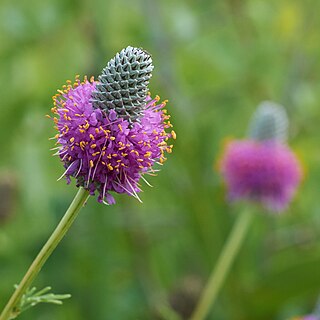
Dalea purpurea is a species of flowering plant in the legume family known as purple prairie clover. Native to central North America, purple prairie clover is a relatively common member of the Great Plains and prairie ecosystems. It blooms in the summer with dense spikes of bright purple flowers that attract many species of insects.
The Black Andrew Nature Reserve is a protected nature reserve located on the south west slopes of New South Wales, Australia. The 1,559-hectare (3,850-acre) reserve is situated on the southern shore of Burrinjuck Dam on the Murrumbidgee River, an important reservoir for the Murrumbidgee Irrigation Area.

Asclepias sullivantii is a species of flowering plant in the milkweed genus, Asclepias. Common names include prairie milkweed, Sullivant's milkweed, and smooth milkweed. It is native to North America, where it occurs in the central United States and Ontario in Canada.

Indigofera heterantha, commonly known as Himalayan indigo, is a species of flowering plant in the legume family Fabaceae. It is native to the northwestern Himalayas of Tibet, in Asia.

Baptisia bracteata, otherwise known as longbract wild indigo, long-bract wild indigo, long-bracted wild indigo, plains wild indigo, cream false indigo, or cream wild indigo, is a perennial herbaceous plant in the Fabaceae (bean) family that is native to the central and eastern United States. It is one of the earliest blooming species of Baptisia, beginning to bloom in March in certain areas of the United States. The flower clusters (racemes) spread out sideways or sprawl across the ground, unlike most other Baptisia species, which have vertical racemes.

Ceriops australis, the yellow mangrove or smooth-fruited yellow mangrove, is a species of mangrove in the family Rhizophoraceae, native to tropical northern Australia and southern New Guinea. It is a common species in the region and although mangroves are threatened by habitat destruction and climate change, the International Union for Conservation of Nature has assessed its conservation status as being of "least concern".

Indigofera decora, commonly known as summer wisteria, is a species of shrub native to China and Japan that has since been introduced to Australia and Sri Lanka. A member of the genus Indigofera, its family is Fabaceae and is used primarily for decorative purposes, though it has also been used to make indigo-colored dye.
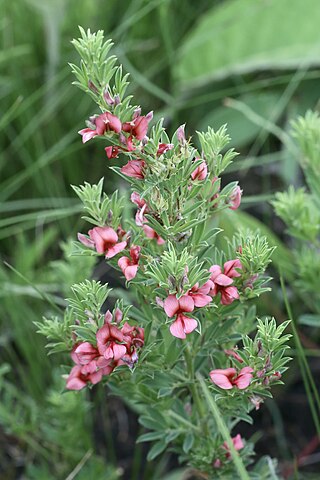
Indigofera hilaris, the red bush indigo or gay indigofera, is a species of leguminous shrublet in the genus Indigofera.


